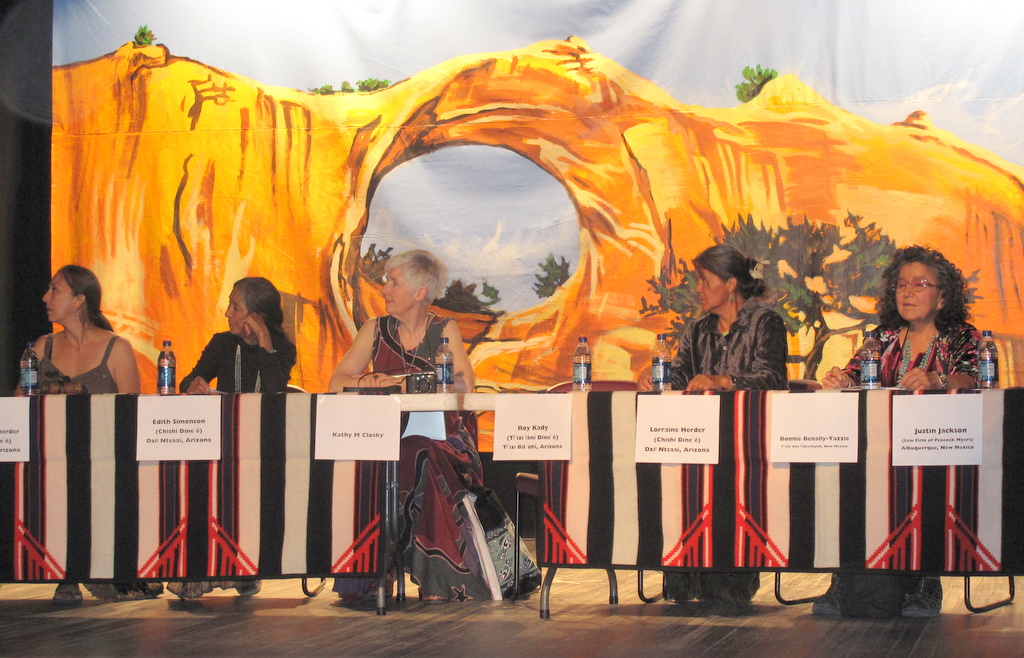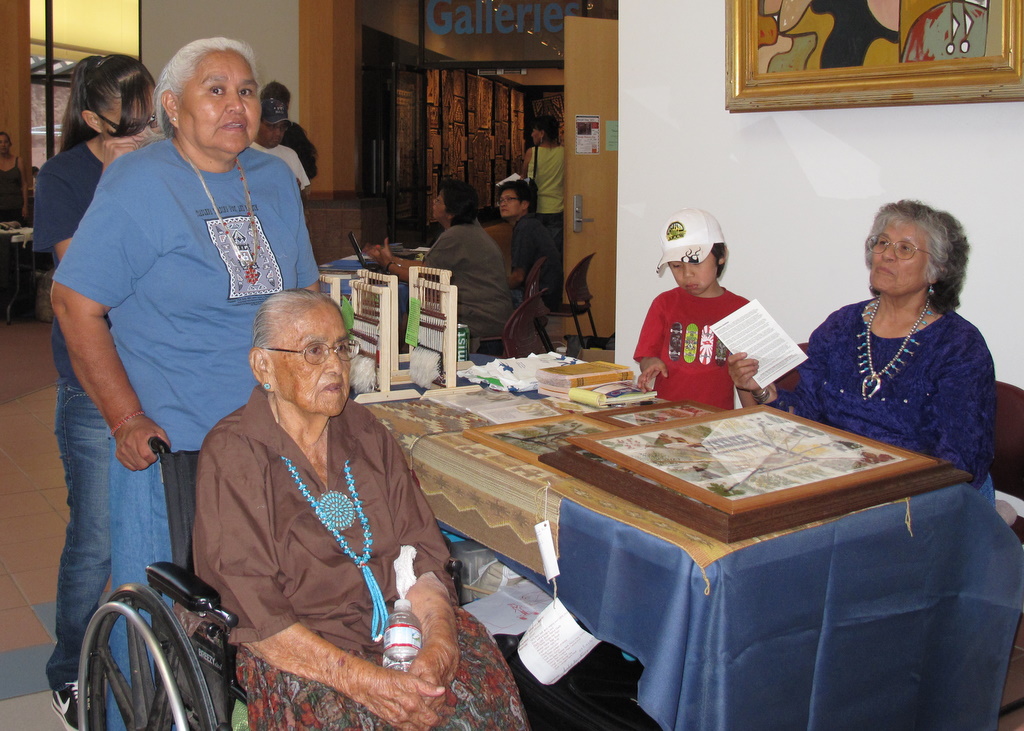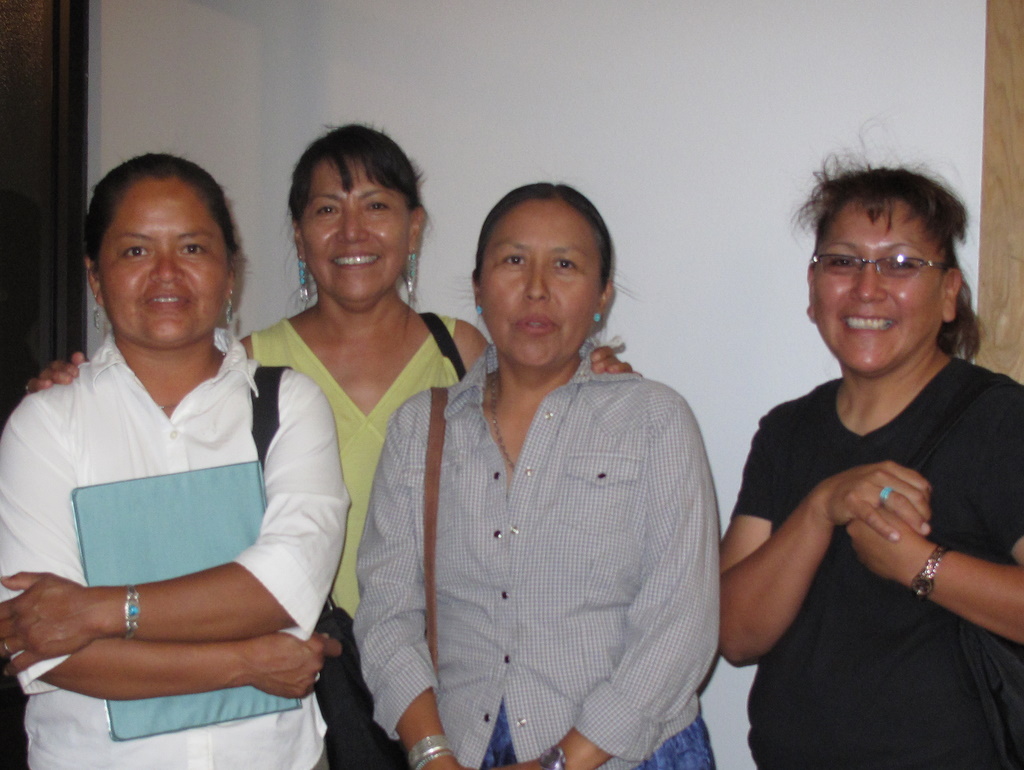Weavers and Their Stories: Dinéjík’éhgo ‘Atło (Weaver’s Day) in Window Rock
Click on any picture for a closer view

From left, Nicole Horseherder, Edith Simonson, Kathy M’Closky, Lorraine Herder and Bonnie Benally-Yazzie at the Weaver’s Day symposium.
Tempe, AZ As I planned to, I attended last Friday’s Dinéjík’éhgo ‘Atło (Weaver’s Day) at the Navajo Nation Museum in Window Rock. I thought that I’d probably write an article on the event over the weekend, but it took me a couple of extra days to distill the event, organize my thoughts and sort through the issues raised, particularly at the symposium and in Bennie Klain’s documentary, Weaving Worlds (which is well worth your time to watch, by the way).
The agenda focused on the economic difficulties that weavers face in marketing their work. Today, by my count, there are fewer than 10 places that are actually on the Navajo Nation where a weaver can sell textiles. The trading post system has been replaced by convenience markets that do not deal in craft items of any kind. Weavers must look to traders in the “border towns” of Gallup, Farmington, Flagstaff, Cortez and Durango, try their luck with rug auctions like Crownpoint and Friends of Hubbell or travel to Phoenix, Albuquerque or even Denver. Internet alternatives like Ebay or an individual web site can present daunting technical and linguistic challenges. A very fortunate few weavers have developed channels to sell their work directly.
The concentration of weaving in towns like Gallup works to depress prices by aggregating the supply, and as trader Perry Null observes in Weaving Worlds “I just can’t buy every rug that comes in”. Many would argue that traders don’t pay enough for what they do buy. Further frustrating several of the weavers in the documentary and symposium is the under-appreciation of handspun and handcarded work and grossly unfair competition from “knock off” copies of Navajo designs woven in other countries.
Since the event lasted only one day, there was scant time to totally define problems, let alone talk about solutions. Several weavers in the audience discussed the possibility of forming an organization on the order of a weaving guild that could pursue the interests of the weavers and help bring the Navajo weaving community more into the mainstream of other professional handweavers. Kathy M’Closkey, author of Swept Under the Rug, noted differences in Canadian versus U.S. copyright laws that would help to protect indigenous designs from appropriation if adopted in this country. TahNiiBaa Naataanii eloquently made the case for a return to the use of Navajo textiles by Navajo people, noting the cultural pride and appreciation that she receives when she wears the shoulder blanket that she wove on a cold morning at the Shiprock Fair. I can only hope that TahNiiBaa’s words were heard and appreciated by the groups of young people who were in the audience.
From my point of view, Weaver’s Day represented a real step forward in establishing a format for naalyéhé (work that results in progress). Char Kruger of the Navajo Nation Museum is looking into the possibility of doing the event annually, noting the need ” to educate our children, our people and visitors in how beautiful our Dine culture is….and how much people are hungry for culture”. I support Char in this goal and in the goal of bringing the whole weaving community, weavers, collectors, educators, traders and students together to identify problems, work on solutions and to celebrate the richness of Navajo weaving.
Hagoshíí (so long for now)
Mary Walker




Hi all,
VisionMaker Video has announced a Summer special on the Weaving Worlds DVD. Just $23.95 (plus shipping) for home use, and $185 for libraries, universities, and museums.